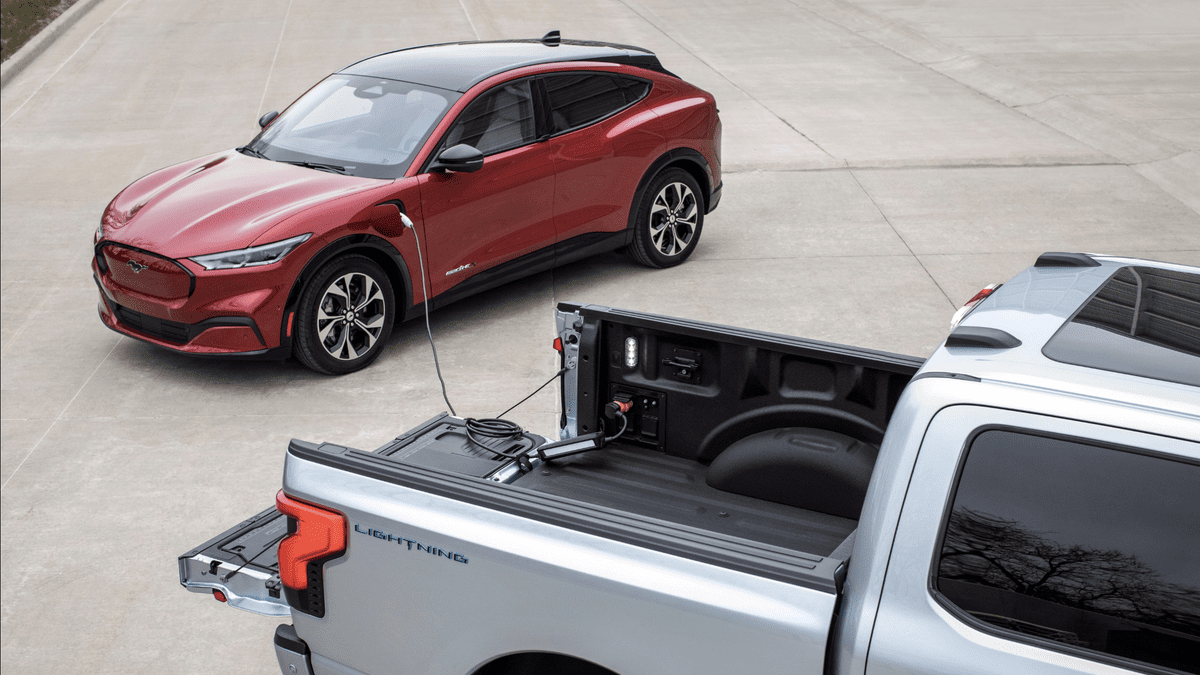Ford's New Battery Chemistry Aims to Boost Capacity and Cut Costs

Photo: Ford
Ford appears to have some big battery improvements coming down the pipeline. The automaker says it now plans to add a new battery cell chemistry to its electric vehicles that will not only increase capacity, but also make them cheaper to build.
According to Ford, the plan is to add lithium iron phosphate cells to the standard-range version of the Mustang Mach-E in 2023 and to the F-150 Lightning the year after that. Right now, Ford uses nickel cobalt manganese battery packs for these vehicles, and the move to the new battery cell chemistry will reduce material costs for the two vehicles by 10 to 15 percent.
This announcement is just one in a series of EV initiatives Ford announced Thursday morning. The company wants to ramp up global electric vehicle production to 600,000 vehicles next year, and 2 million EVs by 2026. FoMoCo says it has already secured all the battery cell capacity needed to hit next year’s target, and it has 70 percent of what it needs for its lofty 2026 goal.
“Ford’s new electric vehicle lineup has generated huge enthusiasm and demand, and now we are putting the industrial system in place to scale quickly,” said Jim Farley, Ford’s president and CEO, and president of Ford Model e. “Our Model e team has moved with speed, focus and creativity to secure the battery capacity and raw materials we need to deliver breakthrough EVs for millions of customers.”
Image: Ford
G/O Media may get a commission
41% Off
LG Oled 55″ Smart TV
Pretty
Aside from being 55″ in size, this OLED TV has over 8 million pixels for truly stunning images, incredibly depth of blacks, and vibrant colors, uses an a7 Gen 4 AI Processor for 4K imaging, has low latency if you’re after a good gaming TV, and even has integrated Google Assistant and Alexa.
This is Ford’s model breakdown for how they’ll actually hit that 600,000 global EVs mark next year.
270,000 Mustang Mach-Es for North America, Europe and China150,000 F-150 Lightnings for North America150,000 Transit EVs for North America and Europe30,000 units of an all-new SUV for Europe, whose run rate will significantly ramp in 2024
The addition of lithium iron phosphate cells is said to create more capacity for high-demand vehicles, as well as extend overall battery life with less range loss. Possibly more importantly is that the new chemistry reduces reliance on scare battery materials like nickel, according to Ford.
The new battery packs are being sourced from Contemporary Amperex Technology Co., Ltd (CATL) — a Chinese company that has been around since 1999. However, Ford will still work with LG Energy Solution and SK Innovation on its packs.
Ford says it plans to invest over $50 billion in EVs through 2026.
“This is our opportunity to win a whole new group of customers, building their loyalty and advocacy as we grow our market share,” said Marin Gjaja, Ford Model e chief customer officer. “We’re developing the digital and physical services and experiences those new customers expect when they purchase a product that to them is a new technology purchase. Our aim is to combine the convenience of digital shopping with Ford’s expertise, scale and the physical presence of our dealers to create the best possible experience for tomorrow’s EV owners.”



